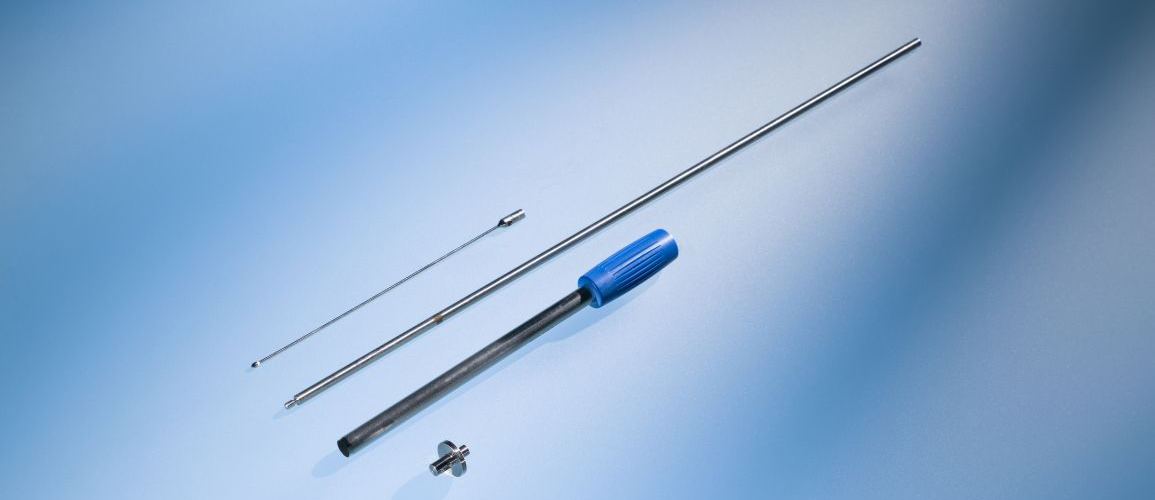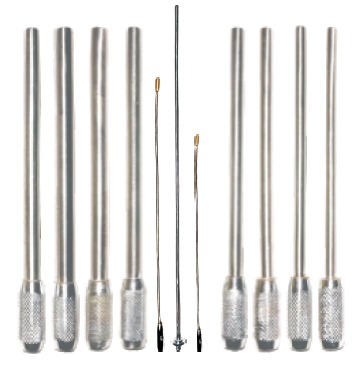Anal Fistula Coring Device
Anal Fistula Coring Device
Welcome to the Anal Fistula Coring Device product manual. It intends to serve as a guide for the safe and effective use of Proctocor in the management of anal fistulas.
The Anal Fistula Coring Device is a versatile tool designed for precise cutting and coring of fistulous tracts. Its availability in 8 different diameters allows it to accommodate various tract sizes, making it suitable for a wide range of cases. Made of high-quality materials, it ensures durability and reliability. It can be used in linear and curvilinear tracts, further enhancing its versatility and empowering the user with a comprehensive solution. The device has a standard length of 7.5 inches and is available in different diameters of 4mm, 4.5mm, 5mm, 5.5mm, 6mm, 6.5mm, 7mm, and 7.5mm.

Know about the Instrument
Malleable probe: This tool is designed for easy manipulation of the fistula tract and insertion of the coring device to facilitate the coring process.
Shaft: The device has a shaft of 2.5mm diameter and a standard length of 12 inches. It has been designed for the smooth movement of the cutter while coring out tracts of smaller diameters.
Base Plate: This component provides resistance at the internal opening to ensure complete transection of the fistula tract, aiding in the thorough coring process.
Circular blade: It allows precise and uniform coring.
Number of pieces (12)
- Number of pieces (12)
- One base plate
- One shaft of 2.5mm
- Two malleable probes of different sizes

Reusable and Autoclavable: The cutter’s handle is made of a material that can be autoclaved.
Why use the Anal Fistula Coring Device: ProctoCor
To core out the distal fistula tract without creating large raw areas.
Indications
Any fistula tract up to 7.5mm in diameter and 7.5 inches in length.
Contraindications
- Fistula tracts associated with an abscess
- Immature tracts
- Extensive fibrosis surrounding the fistulous tract
- Supra sphincteric tracts
- Patients with bleeding disorders or on anticoagulants
Other indications
The device may also be used to core out the pilonidal sinus tract.
Why should the fistula coring device be used for curvilinear tracts?
Whether curvilinear or linear, a fibrous fistula tract consists of fibrous connective tissue (Reference 1 and 2). This tissue is toughened, even though connective tissue is inherently elastic. The toughening occurs due to the deposition of fibroblasts, which is a part of the normal healing process.
A fistula coring device, despite being rigid, can effectively be used to core fibrous fistula tracts. This is due to the tract’s mild elasticity which helps the device to navigate to the contours of the tract, facilitating the coring of fibrotic tissue.
Steps of Procedure
(1) Prepare and position the patient.
(2) Identify the internal and external openings.
(3) Select the appropriate diameter of the device based on the size of the fistulous tract.
(4) Insert the malleable probe attached to the shaft through the external opening and carefully advance it to bring it out of the internal opening. Do not thrust the probe; otherwise, a false passage will be created.
(5) Once the malleable probe comes out of the internal opening, separate it from the shaft. Attach the base plate at the tip of the shaft to rest it against the internal opening.
(6) Insert and rotate the circular blade clockwise, over the shaft, to core out the fibrous fistula tract.
The coring is completed once the circular blade emerges from the internal opening. Separate the base plate and remove the device. The tract can be seen inside the cutter. Flush the cutter and the tunnel from where the fistula tract has been cored out. Usually, the full tract can be seen, but it may come out in parts when it is not completely mature. If no tract is seen, it indicates that either the tract size or the size of the cutter was not appropriate or the tract was not mature enough.
Once the tract is cored out, a tunnel is closed by taking circumambulation stitches over the probe.
Cored out fistula tract


